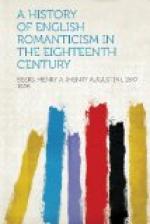The regeneration of English poetic style at the close of the last century came from an unexpected quarter. What scholars and professional men of letters had sought to do by their imitations of Spenser and Milton, and their domestication of the Gothic and the Celtic muse, was much more effectually done by Percy and the ballad collectors. What they had sought to do was to recall British poetry to the walks of imagination and to older and better models than Dryden and Pope. But they could not jump off their own shadows: the eighteenth century was too much for them. While they anxiously cultivated wildness and simplicity, their diction remained polished, literary, academic to a degree. It is not, indeed, until we reach the boundaries of a new century that we encounter a Gulf Stream of emotional, creative impulse strong enough and hot enough to thaw the classical icebergs till not a floating spiculum of them is left.
Meanwhile, however, there occurred a revivifying contact with one department, at least, of early verse literature, which did much to clear the way for Scott and Coleridge and Keats. The decade from 1760 to 1770 is important in the history of English romanticism, and its most important title is Thomas Percy’s “Reliques of Ancient English Poetry: Consisting of Old Heroic Ballads, Songs, and Other Pieces of our Earlier Poets,” published in three volumes in 1765. It made a less immediate and exciting impression upon contemporary Europe than MacPherson’s “Poems of Ossian,” but it was more fruitful in enduring results. The Germans make a convenient classification of poetry into Kunstpoesie and Volkspoesie, terms which may be imperfectly translated as literary poetry and popular poetry. The English Kunstpoesie of the Middle Ages lay buried under many superincumbent layers of literary fashion. Oblivion had overtaken Gower and Occleve, and Lydgate and Stephen Hawes, and Skelton, and Henryson and James I. of Scotland, and well-nigh Chaucer himself—all the mediaeval poetry of the schools, in short. But it was known to the curious that there was still extant a large body of popular poetry in the shape of narrative ballads, which had been handed down chiefly by oral transmission, and still lived in the memories and upon the lips of the common people. Many of these went back in their original shapes to the Middle Ages, or to an even remoter antiquity, and belonged to that great store of folk-lore which was the common inheritance of the Aryan race. Analogues and variants of favorite English and Scottish ballads have been traced through almost all the tongues of modern Europe. Danish literature is especially rich in ballads and affords valuable illustrations of our native ministrelsy.[1] It was, perhaps, due in part to the Danish settlements in Northumbria and to the large Scandinavian admixture in the Northumbrian blood and dialect, that “the north countrie” became par excellence the ballad land: Lowland Scotland—particularly




